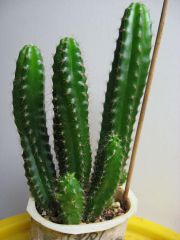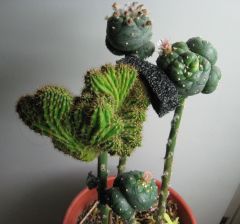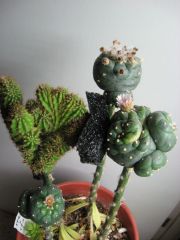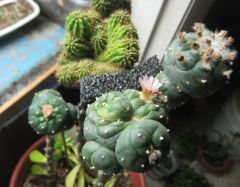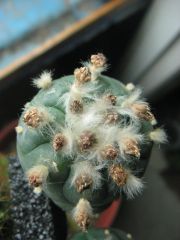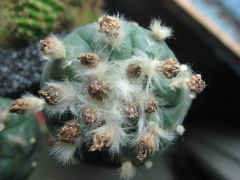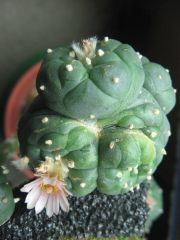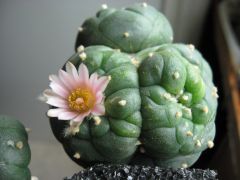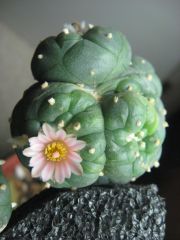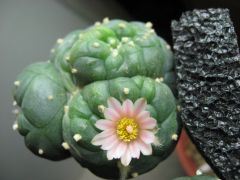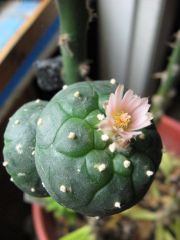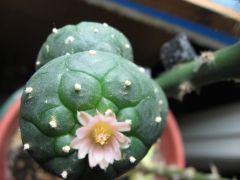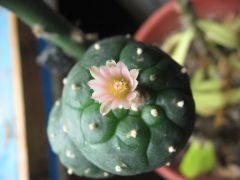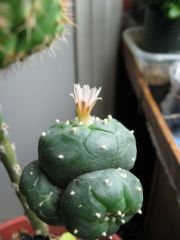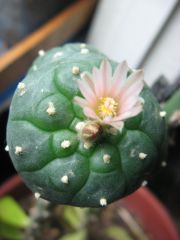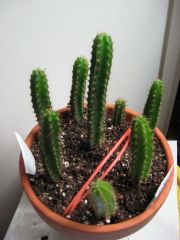-
Posts
1,068 -
Joined
-
Last visited
-
Days Won
9
Content Type
Profiles
Forums
Events
Blogs
Gallery
Store
Everything posted by hookahhead
-
From the album: Seedlings
-

1st Loph flowers < 6 months (16 @ 230 days)
hookahhead replied to hookahhead's topic in Cacti & Succulents
I was out of town the past couple of days. I had a great weekend, but confess that I was a bit concerned the flowers would open in my absense. While I would hate to miss the beautiful show, it was the fresh pollen that I didn't want to lose. So naturally, when I finally made it home, the first thing I did was check on my plants. This flower was just opening. I have noticed they are fairly photosensitive (some more than others) and have had a few try to close while I was taking pictures. I had to be quick, because that's exactly what was happening to this one. Absolutely stunning! I think I see another bud on my cv. "nymphomaniac" or cv "Truffula Tree" ? I should have known they would wait patiently for me to get home... -
I am starting this thread to make others aware of how they can support this wonderful community. I've recently messaged Evil Genius and Torsten about my desire to donate to SAB. Torsten had this to say... I would like to encourage others who have the means/desire to make a donation in the name of "SAB Community". If you make a donation, please post about it here so that we can get funds to the appropriate organizations. However, please do not post the donation amount, this is not a competition! If your favorite organization isn't listed, feel free to suggest it. http://erowid.org - We are a small nonprofit that runs the #1 drug information website in the world. We have only 4 staff but serve 12 million users, and have costs like any other big website: servers, power, office space, programs, and staff. To protect our independence, we don't run ads or take government funds. If Erowid is useful to you, take a minute to keep it online and ad-free another year.http://prism.org.au - PRISM is a non-profit organization that relies on community support to fund our research. Become a PRISM subscriber and help us establish psychedelic compounds as legally available medicines. All donations to PRISM Inc (ABN 96 575 647 082) over $2 AUD are tax-deductible in Australia. http://www.entheo.net/ - For close to a decade the EGA conference has provided a major meeting place for ethnobotanical enthusiasts and specialists in Australia to share information and celebrate community. The EGA conference consists of lectures, workshops, discussion panels, cinema, performance, music and art. The event hosts an array of speakers from across Australia and abroad, and aims to address the issues relating to drug use from social, cultural and traditional perspectives. The EGA conference program draws on therapy, biology, pharmacology, psychology, neuroscience, anthropology, botany, visionary art, culture, politics, law and more, to provide a realistic context of the role drugs and altered states play in the modern world. http://www.treesforlife.org - Most gifts go to just one person. But give someone a Trees for Life Gift from the Heart, and you make the whole world a better place. Your friend or loved one will receive an acknowledgment of your gift. Gifts from the Heart are perfect for holidays, birthdays, weddings, baby announcements, anniversaries, memorials, and other occasions. These are gifts of empowerment and hope. http://www.kiva.org/team/ethnobotanists - We are a loosely affiliated group of people who come from a diverse range of backgrounds. Our common passion is the recognition that humans, as a species, have evolved alongside plants to get where we are today, and that we could not have done so without them (whether it be for food, medicine, spiritual or cultural development, shelter, or even just aesthetics). We cherish the ongoing roles these plants play in our lives, and defend our right to continue and nurture this relationship. Lenders from this team make loans with the goal of improving the lives of people less fortunate than themselves. A significant portion of the funds raised for these loans come from selling, trading, and sharing plants, with the vision of further extending the growth these plants have brought to human existence. http://www.thesmithfamily.com.au/ - Help break the cycle of disadvantage. More than 638,000 Australian children are living in jobless families today1. These young Australians need your support to participate fully in their education and break the cycle of disadvantage. You don’t have to live in one of the 96 communities we work in to show you care. From volunteering in one of our retail stores to holding your own fundraising event or running the famous City2Surf to raise money for us, there are lots of ways to get involved. Join the thousands of caring Australians who are passionate about helping disadvantaged children create a better future for themselves through education.Today, I donated to both Erowid and Trees for life. One last thing...
-
From the album: Worms
If you would like to make a donation in the name of the SAB community, please see this post: http://www.shaman-au...showtopic=38580 -
Have you come across any that have rocks hot glued to the surface of the pot? We should all kall and file krazy reports about how teenagers konsumed their "kosmic kaktus"
-
Yeah, I've rescued/been gifted a few from these places. Mine all had straw flowers The Parodia haselbergii I got last year flowered 3x for me this year. It had an ugly faded blue strawflower, but instead flowered beautiful orange/red flowers. I wonder what people think when they start flowering noting like the ones glued on them. I guess most of them don't live that long...
-

Comparing Cultivars of the main three trich's
hookahhead replied to deadhor5's topic in Cacti & Succulents
Honestly, I'm not sure if this is a compliment or a jab, but I'll assume it's a compliment. Thanks. To be clear, I am an ecologist, I study whole systems, including abiotic factors. Though I do tend to be focused on plants. I simply think plants are amazing; they provide food, shelter, medicine, fuel, and of course some rather interesting side effects. I will be traveling to Costa Rica & Panama in a few weeks to participate in international research; I even get to watch baby sea turtle hatch! This is in addition to my research on plant reproductive trade-offs I have done the past 3 years. I had hoped that deadhor's intelligent and honest response would change your mind about him a bit. I understand his frustration, however slinging insults at each other never helps the situation. You may remember when I really started posting here a lot, I received much of the same attitude from you. I too had been a lurker for a long time before I felt like I had something to contribute. Admittedly, my situation is a bit different because I didn't choose the best way to portray myself. I believe I have done a good job at changing this. Though, it's a bit sad to know that my "crazy" thread that was moved to bitches & gripes received more attention than when I reposted my trichocereus taxonomy paper in a more appropriate manner. I have a lot of respect for you zelly, you have a beautiful collection and been around a good many years. Would you care to share with us why you got into cacti, specifically trichocereus? Many of us were drawn to this species because of their inner beauty, but their true magic is how they make us fall in love with their outer beauty. I certainly fall into this category. Despite my original intent, after 3 years of growing them, not a single cactus has been "harmed". The fact that they have medicinal properties is just another interesting fact at this point.... Bait & Switch. You shouldn't be upset that people are attracted to them for this purpose. It has produced an enormous amount of information, and is the largest contributing factor to their cultivation/distribution world-wide. I'm sure it helps your seed business . I don't see why you've singled out deadhor. After all, I don't see you bashing Trout and his interests are CLEAR. His publications are some of the first many people encounter when researching the topic. Although I have only been into cacti for 3 years, I have been gardening for 25. My father got me into plants, and took me for nature hikes through our beautiful forests. It wasn't until much later that I started researching ethnobotanicals. However, it's not the only reason I am attracted to plant, nor the only plants I grow. -

Organic Soil Creation
hookahhead replied to BCdude888's topic in Sustainable Technologies & Ethical Living
INFLUENCE OF TILLAGE METHODS AND FERTILIZER APPLICATION ON CHEMICAL PROPERTIES OF WORM CASTINGS IN A TROPICAL SOIL.pdf MOBILIZATION OF NUTRIENTS IN TROPICAL SOILS THROUGH WORM CASTING- AVAILABILITY OF MICRONUTRIENTS.pdf MICROBIAL BIOMASS AS AN INDEX FOR TILLAGE-INDUCED CHANGES IN SOIL BIOLOGICAL PROPERTIES.pdf MOBILIZATION OF NUTRIENTS IN TROPICAL SOILS THROUGH WORM CASTING- AVAILABILITY OF MICRONUTRIENTS.pdf MICROBIAL BIOMASS AS AN INDEX FOR TILLAGE-INDUCED CHANGES IN SOIL BIOLOGICAL PROPERTIES.pdf MOBILIZATION OF NUTRIENTS IN TROPICAL SOILS THROUGH WORM CASTING- AVAILABILITY OF MICRONUTRIENTS.pdf MICROBIAL BIOMASS AS AN INDEX FOR TILLAGE-INDUCED CHANGES IN SOIL BIOLOGICAL PROPERTIES.pdf MOBILIZATION OF NUTRIENTS IN TROPICAL SOILS THROUGH WORM CASTING- AVAILABILITY OF MICRONUTRIENTS.pdf MICROBIAL BIOMASS AS AN INDEX FOR TILLAGE-INDUCED CHANGES IN SOIL BIOLOGICAL PROPERTIES.pdf -

Organic Soil Creation
hookahhead replied to BCdude888's topic in Sustainable Technologies & Ethical Living
Wow, excellent replies everyone! Sally brings up a lot of good points. I am not a die hard organic either, I only grow and do what I can to organic. I don't buy organic as often as I'd like, and I don't eat at organic restaurants. Plastic is unavoidable, but because it's free and readily available a lot of the time, I often use it in my garden. If you look at some of my other posts, you'll see I live rather cheaply. However, I don't see myself as dirt poor, I;m dirt rich! I have a giant bin of worms, that are fed high quality food, and produce fresh castings. Store bought castings suck. The worms are all fed peat, and the castings are dried out to much. Franky, I would like to offer you a different perspective. That human inovation has destroyed MILLIONS of years of evolution. I'm not even referring to GMO, I'm talking extinction. The billions of people that are supported by this system are destroying the planet at an ever accelerating pace. I This is a section from my final assignment in an agricultural ethics class. It's easier than retyping how I feel. -
Last week I mixed up a big tub of soil, with the intent of potting up some cacti. However, I still lacked one key ingredient... pots! Tonight I was hellbent on playing in some dirt. So I looked around a bit, hoping that I find a pot or suitable container. No luck . It was to late to go to the hardware store, plus buying a bunch of clay pots adds up quick... So I did what I do best, sat down and did some thinking Aha! I know what I can do... Let's recycle! Luckily for me, the trash/recycling hauler doesn't come until Monday. So I grabbed 2 milk jugs out of the bin... did a bit more thinking ... and this is what I came up with. Of course, we need some drainage. Instead of just poking some holes in the bottom, I decided to cut some slits instead. After spending over a year trapped in a 6" pot, it took a little finessing to liberate this guy. I almost swear I heard it let out a little sigh of relief. Happy with the results, I went ahead with the other one. A 6" pot hold about a qt, a gallon jug holds about a gallon . Now that's a nice set of jugs if you ask me! While those two certainly needed repotted, it was actually their old containers I was after Psycho0 x TPM TPM x (SS02 x T. Pachanoi) The top part of the milk jug was used for labels. This is how I get all of my labels. I'm sure they're all happy to have a little more leg room!

